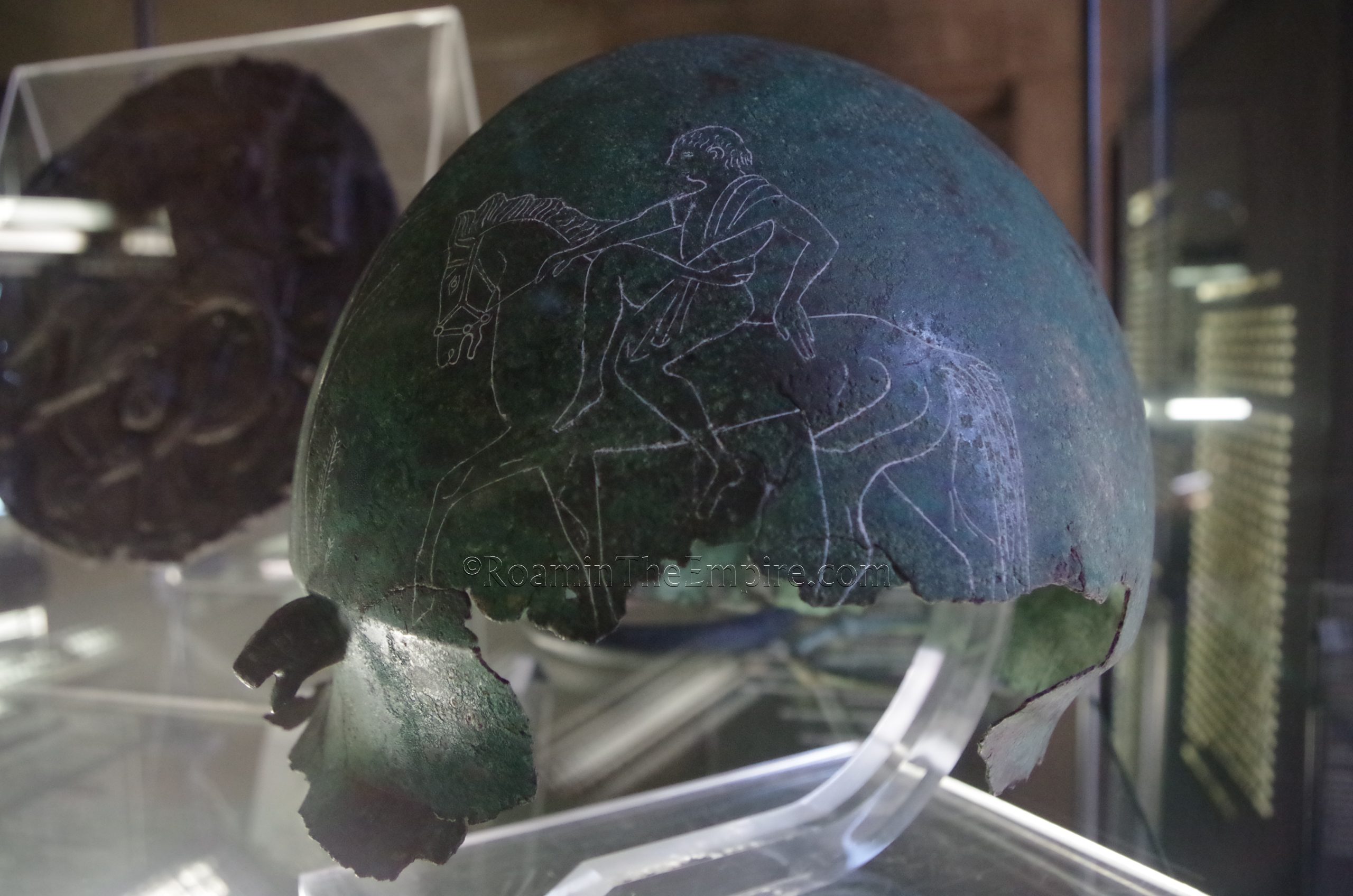
The bustling port city of Ancona, on the Adriatic coast of Italy, seems to have begun life as a small settlement of the Italic Picentes, perhaps dating back to the 8th or 9th century BCE. It grew in importance, but, around 380 BCE a contingent of exiles from Syracuse, fleeing the rule of Dionysius I, founded a settlement here. The name of the settlement, Ancon, is derived from the Ancient Greek word for ‘elbow,’ likely a reference to the elbow shape of the harbor. Being the only natural harbor in the region, Ancona quickly grew in importance. The fertile hinterland and the establishment of a Tyrian purple dye production facility there, which apparently produced a dye that was comparable to that produced in in Phoenicia, helped to solidify the city’s standing.
The history of the city is a bit murky between the years following the Greek settlement and about 178 BCE. The Picentes were allies of Rome around the start of the 3rd century CE, but had then rebelled around 268 BCE, resulting in a conflict that ended with the annexation of most of Picenum, which likely included Ancona, by the end of the decade. The city is noted as being an important naval station for campaigns against the Istrians and Illyrians in 178 BCE. In the latter half of the 2nd century CE, a colony may have been established in the territory of the city. Lucius Cornelius Cinna used Ancona as his starting point for his campaigns against Sulla in the east in 84 BCE.
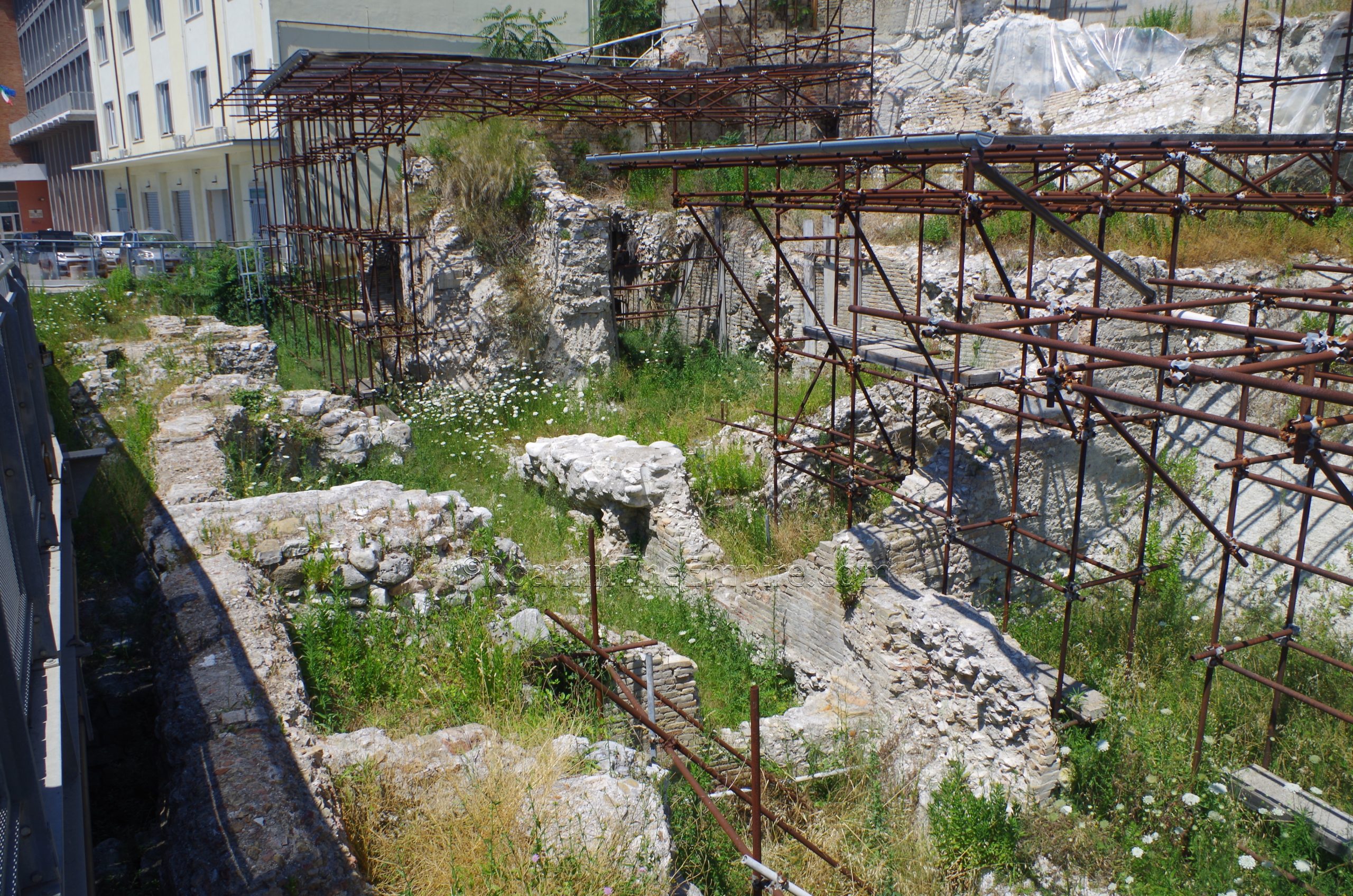
Ancona is noted as being one of the cities that Julius Caesar occupied shortly after crossing the Rubicon, and features frequently in the campaigns of the ensuing civil wars as an embarkation and debarkation point. Two legions of veterans who had served under Caesar and Marc Antony were established as a colony at Ancona, and the city likely officially earned the title of colonia at this point. In the 1st century CE, Pliny the Elder notes Ancona as being responsible for the notable Palmensia wine. Strabo too praises the region around Ancona for its wine and wheat production.
Ancona continued to be a vital port, particularly as a sea link with military actions in the east. The city is famously depicted on Trajan’s column as the starting point of his army as it set sail for Dalmatia and on to Dacia. The importance of the port would lead to Trajan taking a personal interest in the renovation and expansion of the harbor facilities. Some of these were reputedly designed by his architect, Apollodorus of Damascus. Like many other cities in the northern part of the peninsula, Ancona suffered in the Germanic raids starting in the late 3rd century CE, but the city managed to retain some importance through the end of the Roman period.
Getting There: Though modern Ancona is a city of some prominence, it is off the beaten path a little bit and can require lengthy train rides to get there from other major cities. From Rome it’s about 4 hours by train. Even from Bologna, the trip can take between 1:45 for the fast trains and in excess of 3 hours for the slower trains. The nearby Aeroporto delle Marche has very limited domestic and European Union service. Further, parking in Ancona was a rather unpleasant experience; the historic center is essentially sandwiched between hills and is thus very compact and space is at a premium. The distance from other major cities makes it difficult to do as a day via personal vehicle or public transport, but it is a bit more workable from as a multi-day destination or a trip from smaller places in the Marche.
Perhaps the best place to start the walk-through of the archaeological sites of Ancona is in the area of the Museo Archeologico Nazionale delle Marche. There are two small archaeological sites right around the museum. The first is a set of remains of a bathing complex. When heading up Via Ciriaco Pizzecolli, there is a sign at the north side of Piazza Benvenuto Stracca that indicates Terme Romane down the next small, pedestrian street, Vicolo dei Tribunali. At the end of the street is a small covered area, contained in which are some scant remains of baths. There’s no admission, they’re just out in the public space. There’s not a whole lot to see either. It was moderately overgrown, and one can make out some reconstructed hypocaust elements, possibly the pool for the caldarium, it seems. The baths have been dated to the very broad period of the 1st century BCE to the 2nd century CE.
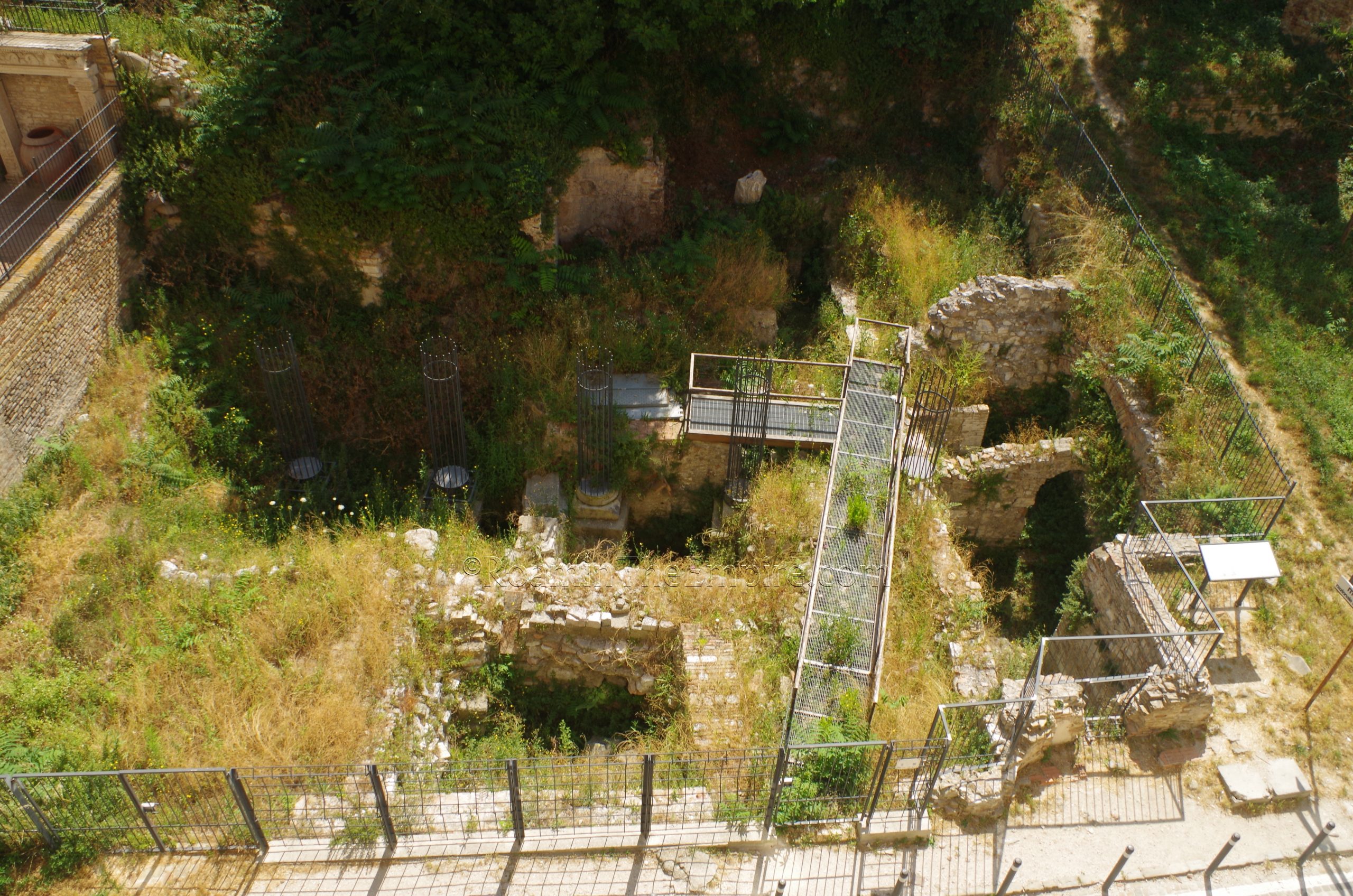
A little farther on, actually right across the street from the entrance to the museum are the remains of the forum. Like the baths, it is in a public area that can be seen at any time, and there is no direct access to the remains. There is a small sign with some English information, but most of it was faded and largely unreadable when I visited. A small platform is present that takes visitors out over the remains, but, the gate leading to it was locked and it didn’t look like it had been open in a while (weeds had grown significantly through the grated floor). Also like the baths, the forum remains were pretty well overgrown, and it was hard to make out much. There did appear to be some later stages of building as well. A couple columns from a portico are reconstructed with iron bars, though, which gives some impression of what would have been the forum portico. There’s a good view down on the site from one of the museum windows, which is honestly the best place to look at the site in order to get any real sense of what is here.
Museo Archeologico Nazionale delle Marche
The Museo Archeologico Nazionale delle Marche is located at Via Gabriele Ferretti 6, in the Palazzo Ferretti. The museum has an alternating opening schedule. It is open Tuesday through Thursday from 8:30 to 13:30. Then Friday through Sunday it is open from 14:00 to 19:30. The museum is closed on Mondays. Admission is 5 Euros.
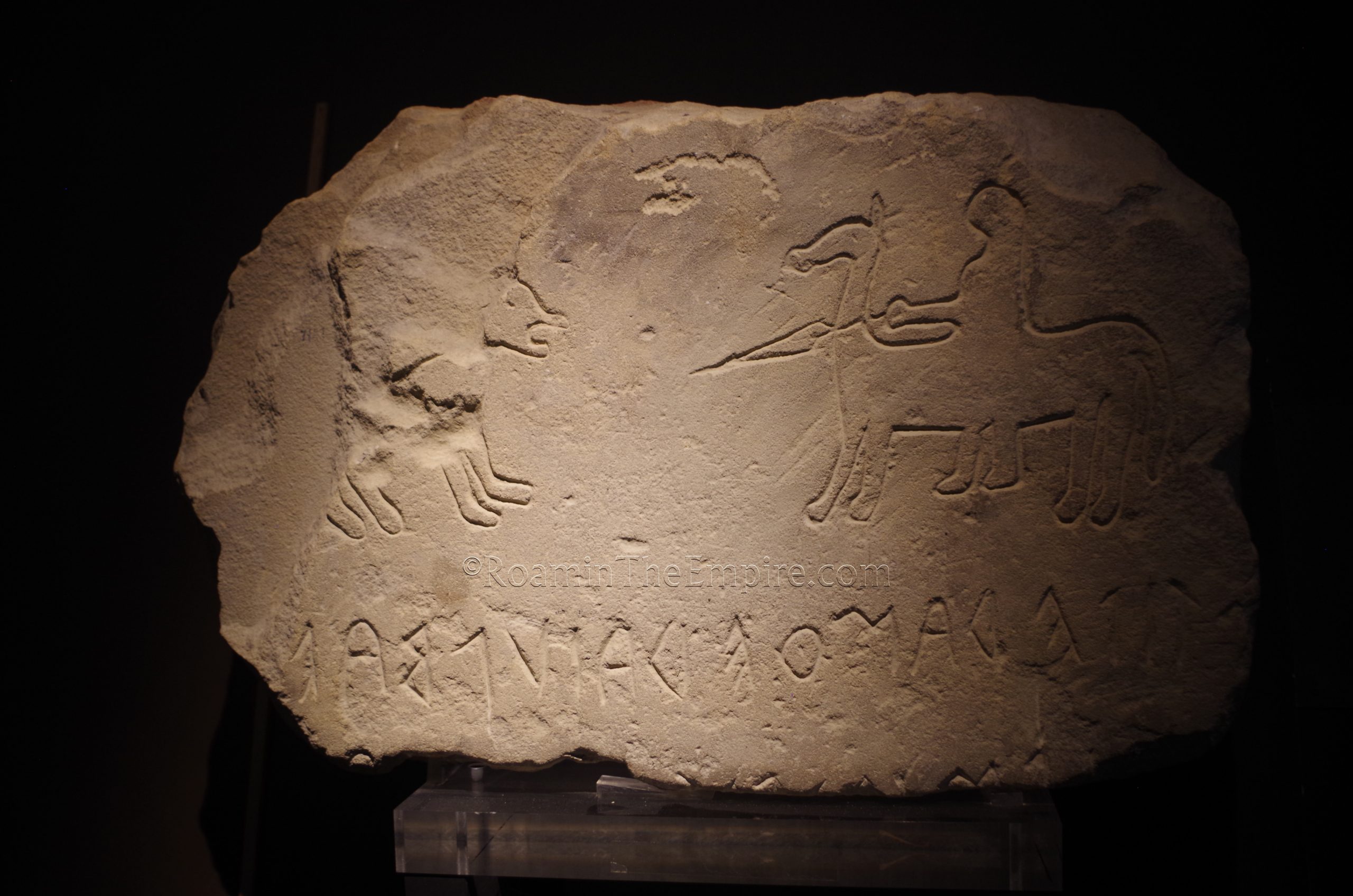
As the name suggests, the museum is dedicated to the entire region of the Marche, and as such, there are finds from all over the region. There’s a pretty good collection of artifacts from the Picene period, mostly related to funerary finds, from various sites dating back to the 9th century BCE. In particular, there were a few bronze helmets with incised decoration that were interesting, and a collection of stele with reliefs and/or inscriptions in the Picene. As the finds approach the 4th century BCE, though, the amount of Greek pottery in the tombs increases noticeably.
Given that Ancona was the only actual Greek settlement in the area, there’s not a whole lot in the way of Greek objects found in a Greek context, as opposed to the Greek goods found in the Picene or Roman context. There were a few local Roman period objects with Greek inscriptions, illustrating the influence of the Greek occupation here. The Roman collection was, surprisingly, much smaller than I expected as well; maybe 15-20% of the entire collection. There are some nice wall paintings and mosaics, along with a number of funerary inscriptions and various statuary fragments. One of the pieces I found particularly interesting was the sarcophagus of a vintner, decorated with Hermes, Dionysus, and a scene of the deceased offering a customer wine.
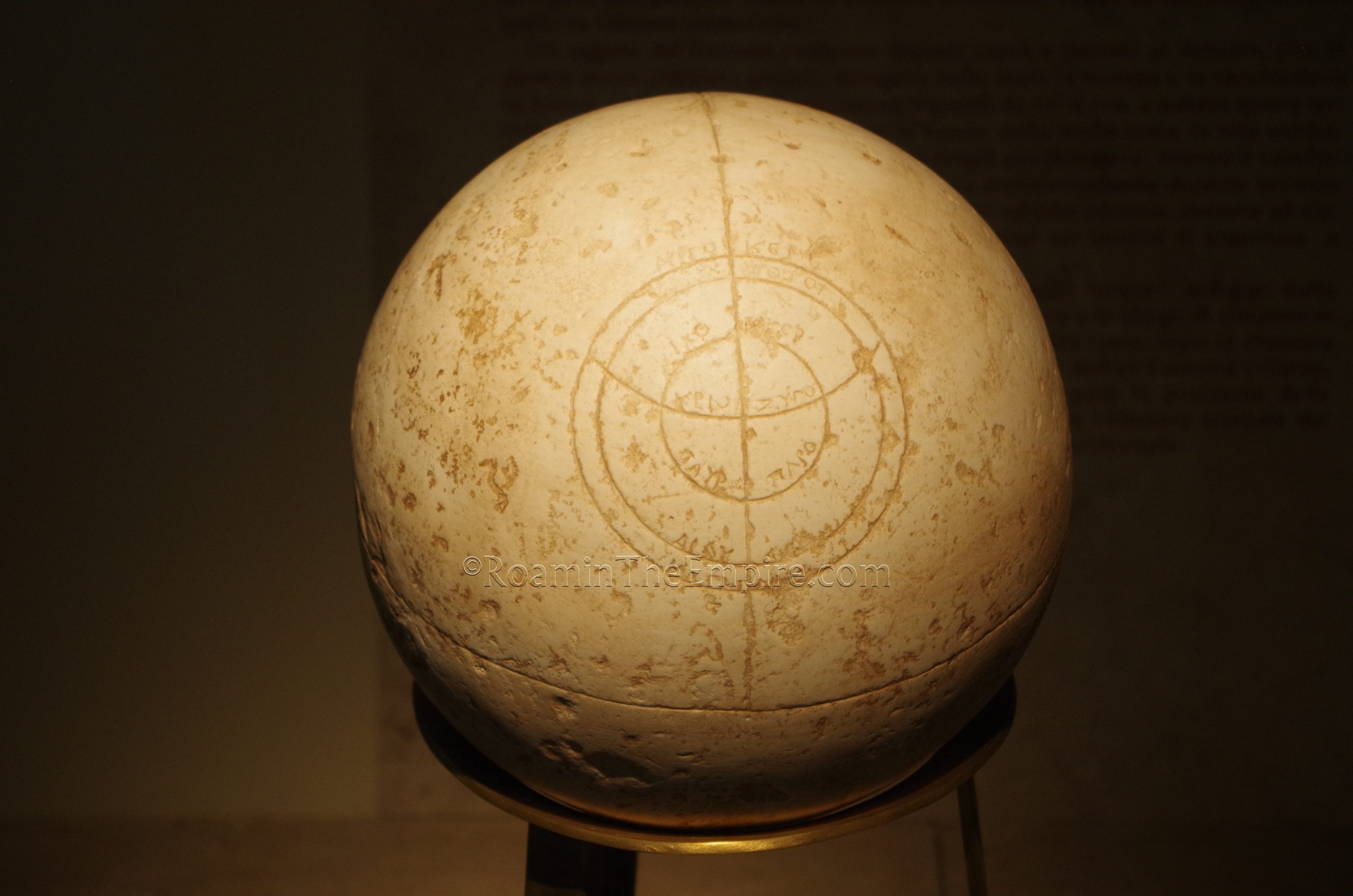
One of the most fascinating objects in the collection, though, was the so-called Globo di Matelica. This 1st-2nd century CE objects is essentially a marble sphere with inscribed lines and Greek words on it. The dating, though, is dependent on the context it was found on, and the object itself could be older. It’s a lot to get into here, but, it is essentially though to be some sort of astronomical solar calendar for tracking solstices and such. It’s similar to other such objects found in Greece, and interestingly is not made for use in the latitude at which it was found in Matelica. There’s an interesting article from an Italian astronomy journal reproduced here (in Italian) that explains a bit more about it.
Overall it’s a nice museum. It has a large collection, and I admittedly went through the pre-Roman stuff a little quicker than I perhaps could have (mostly a time issue due to the museum’s early afternoon closing), but still spent a solid hour and a half there. The Picene necropolis collection had most object descriptions with an English translation, but all the larger informational signs and objects in the Greco-Roman collection were in Italian only. Including the description on the Globo di Matelica, which is why I didn’t really fully appreciate how interesting it was until later when I could spend a bit more time deciphering the information.
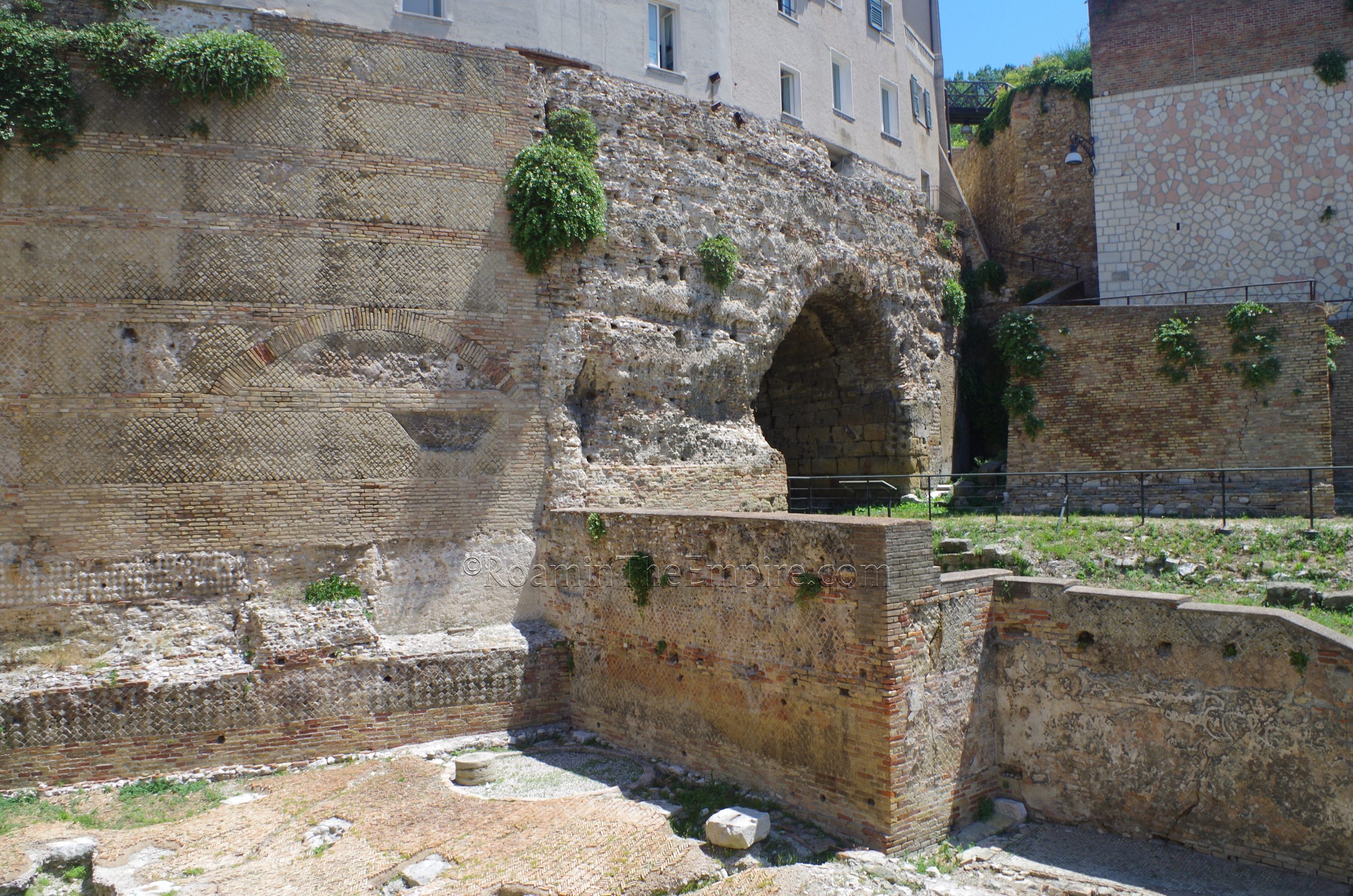
Amphitheater
Just up the street from the museum are the remains of the amphitheater, which is essentially divided into two sort of separate sections. The amphitheater seems to have originally been built during the reign of Augustus with major renovations occurring during the reign of Hadrian. It is estimated to have held about 7,000 to 8,000 spectators. It was abandoned by the 6th century CE and used as a necropolis before some of the walls were incorporated into later structures.
The southern (western) part of the amphitheater is first encountered when coming from the south. This is mostly just the façade of the building, but this is the area incorporated into post-antique buildings. The curve of the amphitheater is pretty clear in the satellite photos of the amphitheater. The area is fenced off, but, the monumental south/southwestern entrance to the amphitheater is visible as well as some of the paving stones outside the entrance. There is also an area of opus spicatum pavement.
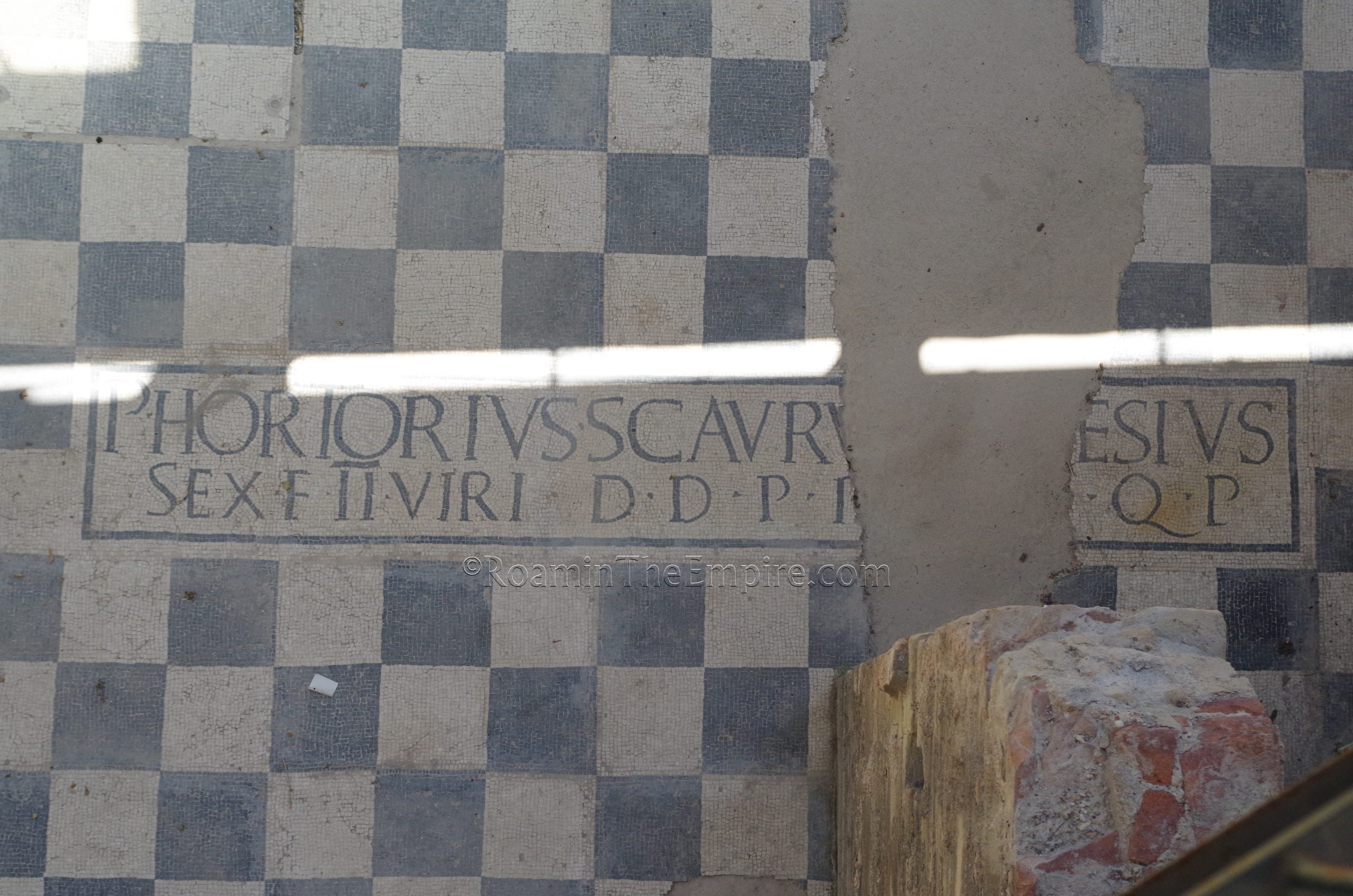
Continuing up there street, there is an area outside the western part of the amphitheater, covered with a modern roof. This area has been identified as perhaps a bathing complex associated with the ludus. Like the amphitheater, this dates to the Augustan period. Most notable are the in-situ mosaics decorating the area, including an inscription noting the construction of the building (or at least this part of the building) by the duumviri Publius Hortorius Scaurus and Gaius Caesius. There’s also some traces of wall painting present.
Further up the street and then over on to Via Giuseppe Biarelli, the rest of the amphitheater, including the interior, is visible. It looks like at one point, it was all accessible, as there are walkways and informational signs within the archaeological area, but when I visited, it was closed and there were no signs noting any sort of opening period or contact information for gaining access to this part of the amphitheater. So presently it seems to only be visible from the street. A lot of post-Roman construction is pretty evident, but some of the original walls of the amphitheater can also be picked out from among those later constructions.
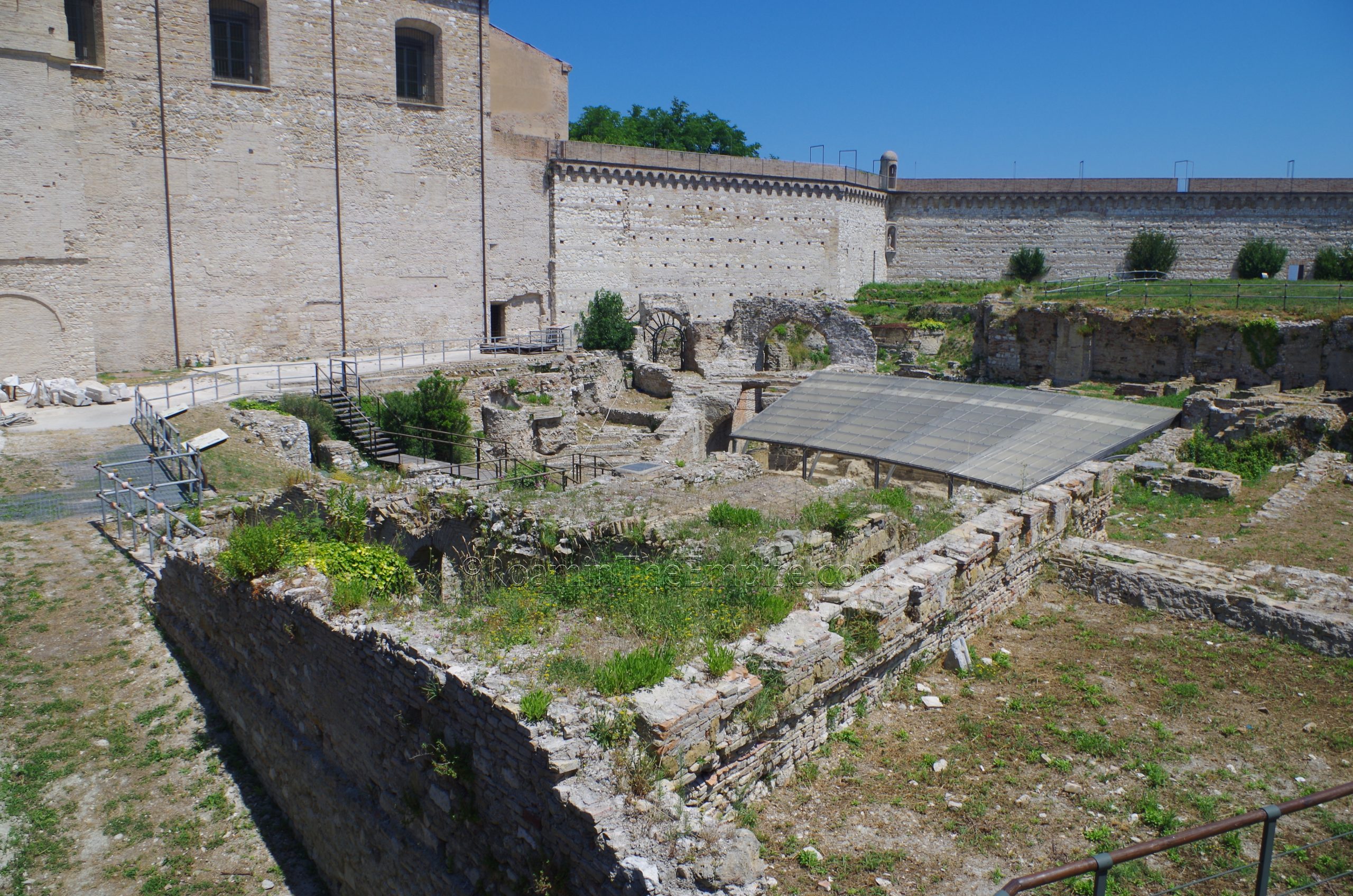
From there, it’s a short walk to the Cattedrale di San Ciriaco. The site of the cathedral, atop the highest point of this hill that made up the core of the historic center, was originally the location of a temple to Aphrodite Euplea in the 3rd century BCE. Venus, according to Catullus and Juvenal, was the patron deity of Ancona. Some very scant remains of this temple can be seen in the crypt of the church, along with the 6th century CE church built on top of it. The cathedral seems to be open daily from 8:00 to 12:00 and 15:00 to 19:00. There is no admission.
Port
From the cathedral, it’s a walk down hill to the modern port area. At the end of Lungomare Vanvitelli is an archaeological area with remains from the port constructions excavated. These primarily date from the Trajanic port improvements, but some areas on either end date from the earlier Augustan port. Some late antique walls are also built on in various places. This area mostly seems to be structures associated with storage for goods unloaded from the port, or in some cases (according to the reconstruction on the informational sign) storage of ships as well as perhaps offices. There is a walkway that leads past the site, but no direct access. When I visited, there was a lot of overgrowth and some less than aesthetically pleasing bars all over holding up the roofing, but even so, it’s pretty easy to see what’s here.
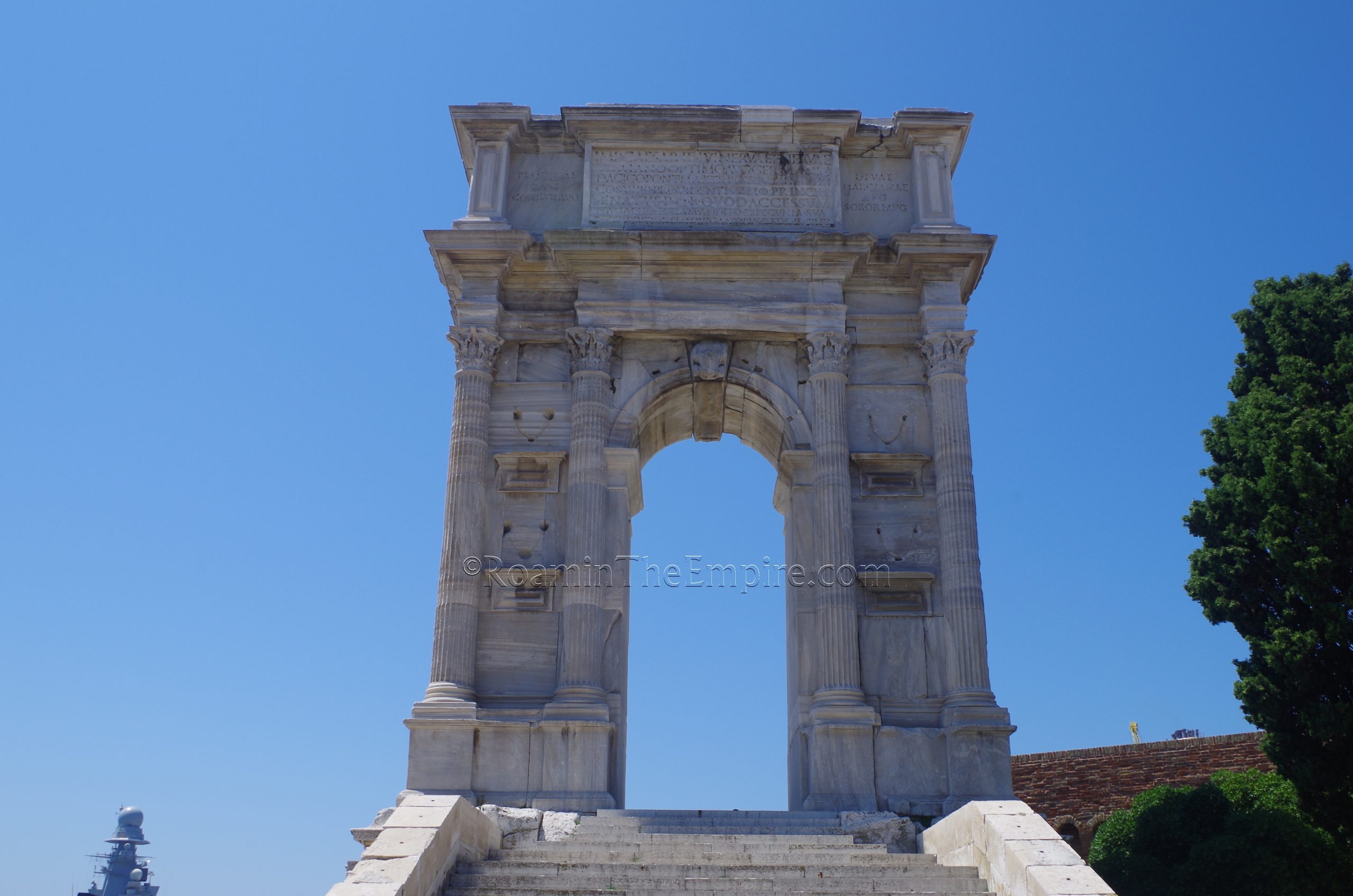
A bit further on, at the north arm of the modern harbor, is the Arco di Traiano, the Arch of Trajan. Like some of the port constructions, this too seems to have been designed by Apollodorus of Damascus. Though the inscription in the attic of the arch would seem to indicate a construction date of 117 CE, the arch is depicted on the Column of Trajan when the armies leave Ancona for Dacia in 105 CE, meaning it would have had to be constructed earlier than that. It was erected in honor of Trajan’s personal contribution to the refurbishment of the port area, perhaps as part of a program to prepare it for supporting the Dacian campaign.
Atop the arch was an equestrian statue of Trajan flanked by, according to the surviving inscriptions, his wife Plotina and sister Ulpia Marciana. Instead of reliefs, the arch was decorated with bronze rostra. The inscriptions were originally enhanced by gilt bronze letters, all of which, like the rostra and statues, have not survived. The arch is in a public space with no fencing or access limitations, so it can be seen and visited at any time.
Overall, the remains of Ancona are pretty easy to fit into a single day, really half a day depending on the museum. It’s mostly the transit to and from the city that can add a lot of time onto an excursion there. Also, though I wasn’t able to visit it, because it’s closed while I was in Ancona and it doesn’t seem to have any sort of regular opening hours; the Chiesa di Santa Maria della Piazza apparently has some 6th century CE mosaics belonging to the early church, as well as some remains of the Greek walls of Ancona visible in its crypt.
Sources:
Appian. Bellum Civile, 5.3.23.
Athenaeus. Deipnosophistaí, 1.48.
Caesar. Commentarii de Bello Civili, 1.11
Catullus. Carmina, 36.
Grant, Michael. A Guide to the Ancient World: A Dictionary of Classical Place Names. New York: Barnes & Noble Books, 1997
Juvenal. Satires, 4.41.
Livy. Ab Urbe Condita, 41.1.
Pliny the Elder. Historiae Naturalis, 14.6
Pomponius Mela. De Situ Orbis, 2.64.
Silicus Italicus. Punica, 8.438.
Stillwell, Richard, William L. MacDonald, and Marian Holland. McAllister. The Princeton Encyclopedia of Classical Sites. Princeton, NJ: Princeton U Press, 1976.



Hello. I lived in Ancona until my eighteenth year, then I went to study at the University in Bologna and never returned to Ancona, although my family still lives there. It is a shame that the Roman remains are left in this state, and I realize that I have never had the opportunity to inquire and visit these places. During school they never took us to see these places, and they never told us about them. Unfortunately, the inhabitants of this city are somewhat refractory to culture, apathetic and obtuse, and this is one of the main reasons why I left the city. the whole city, not just the Roman ruins, has serious management problems. Thank you very much for this wonderful information. Paradoxically provided by a foreigner.